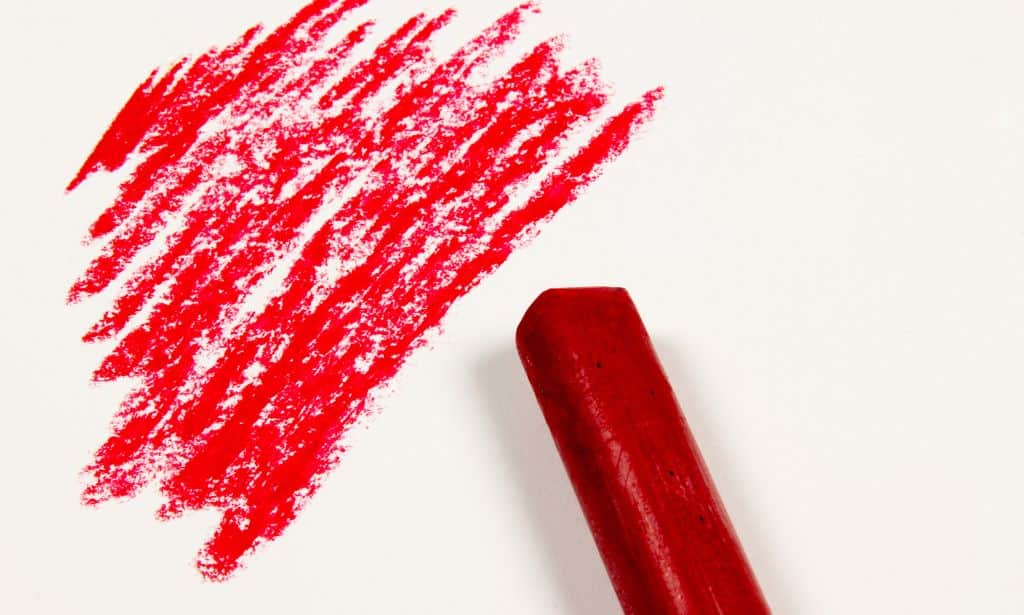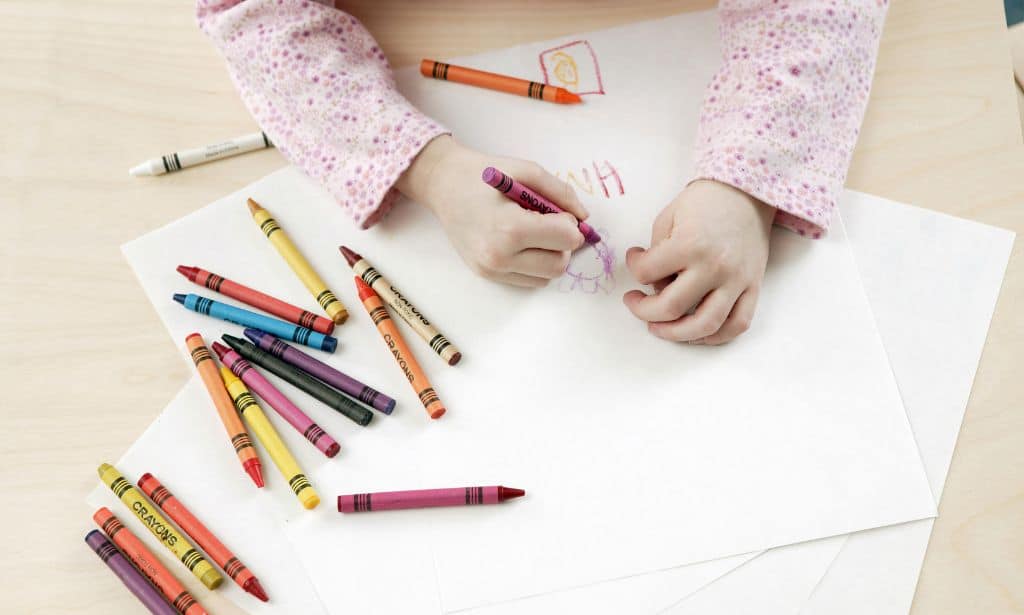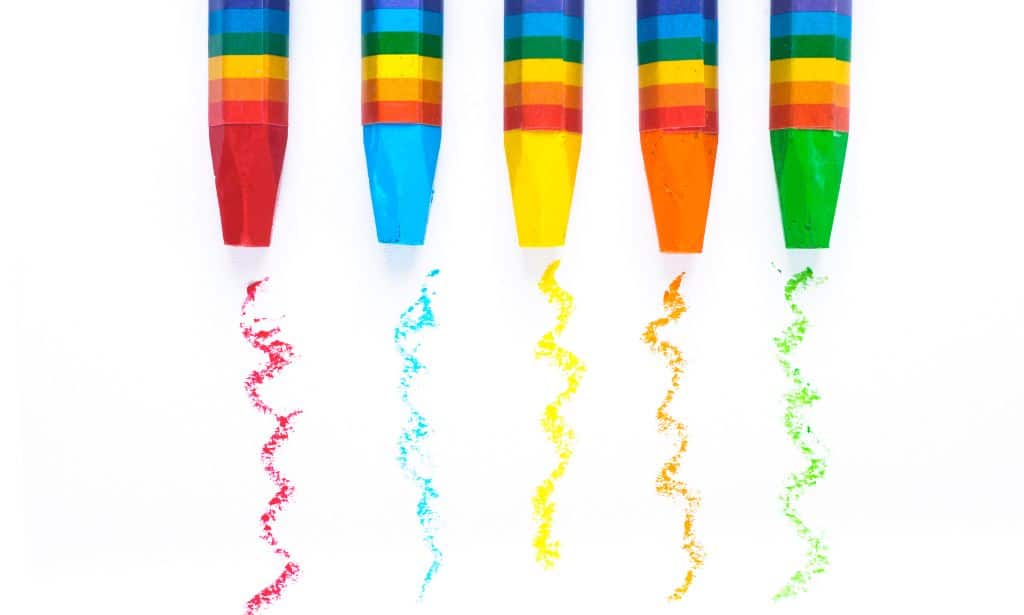Plastic crayons are preferred over regular wax crayons because they are flake-free, smudge-free, and durable. They are also quite affordable, considering how hard the crayons are and the quality of color they produce.
But are plastic crayons safe?
Plastic crayons conform to ASTM D-4236. They have been tested for toxicity and passed. These crayons are also hard to break and do not flake, so your child won’t be ingesting wax particles as they do with wax crayons.
That said, we do not recommend eating plastic crayons or any crayons for that matter. A 2018 study conducted by the U.S Public Interest Research Group revealed that some brands of crayons contain trace amounts of metal, asbestos, and other harmful chemicals that may affect the child negatively when ingested often.

Are All Plastic Crayons Made of Plastic?
Like regular crayons, plastic crayons are also made from wax. However, the wax is mixed with a specific percentage of plastic to improve the product’s durability, color quality, and smoothness.
Regular crayons (the ones we buy at the bookstore) are a mixture of paraffin wax and color pigment. Paraffin wax is a white, solid wax derived from saturated hydrocarbons. Unfortunately, these crayons suffer from low breaking strength, rapid wear rate, poor erasability, and smudginess.
Plastic crayons solve these problems by adding 0.1-10% polyethylene resin, which increases the crayons’ melting point and molecular weight. Polyethylene is a raw plastic material, which, when mixed with paraffin wax, turns the crayon into a hard, smooth, and plastic-looking object.
Of course, other ingredients, such as stearic acid and saponite, are added to the mixture to improve the color quality, scent, and malleability. However, the crayon is still mostly made of wax.
What is the Impact of Plastic Crayons on the Environment?
Every year, over 70,000 pounds of broken crayons end up in landfills in America alone. This is a concerning issue because crayon wax isn’t biodegradable, so it doesn’t break down. Instead, it leaves a waxy sludge that will affect the earth for years. This petroleum by-product mixed with plastic and other chemicals also causes low carbon pollution.
Thankfully, the impact of plastic crayons isn’t as huge. While they mostly make wax crayons, the plastic resin makes them significantly stronger and more durable than regular wax crayons. In fact, a plastic crayon can last thrice as long as a wax crayon, especially since they don’t break and become useless right out of the box.
Plastic crayons will eventually end up in our landfills but not quite as fast as wax crayons. And when the day comes that your crayon is too tiny to be useful anymore, you don’t have to throw them away.
Can You Recycle Plastic Crayons?
Yes, you can recycle a plastic crayon just like wax crayons. And if you don’t know how to do it at home, there are programs all over the country that do this job for free. The National Crayon Recycle Program and The Crayon Initiative, for example, will accept any crayons to recycle and make them into new ones. These organizations alone have prevented over 50,000 pounds of crayons from ending up in your local landfill.
But you know what? You can recycle the plastic crayons all by yourself at home. Remove the paper, mix all the small pieces left over in a microwavable container, and heat them up until they melt. Pour the liquid into small molds for shaping, and you have yourself new crayons.
Are Plastic Crayons Safe for Use by Children?
Plastic crayons are non-toxic and safe for children to use. In addition, the plastic component makes them stronger and smudge-free, so they don’t stain the child’s hands when coloring.
However, we only recommend plastic crayons for kids over the age of three. This is because kids below three are more prone to eating crayons, which can cause an upset stomach and diarrhea or be a choking hazard.

How to Identify the Best Crayons for Children
Plastic crayons come with many benefits you don’t get with wax crayons. They have impressive color versatility, glide smoothly on paper, and don’t smudge or break easily. But that doesn’t mean you should pick up any plastic crayon brand you find out there.
Here are a few features you must consider to get only the best crayons for your little one.
1. Non-Toxic
Your baby’s safety has to come above all else. This is why you should only buy plastic crayons that have gone through the correct testing procedures for toxicity and safety. you want crayons that are labeled ASTM D-4236. Be sure also to check the ingredient list and even search for reviews online to ensure you are buying something that’s safe.
2. Washable
Like all children, expect your baby to draw on your walls, couch, and even their own clothes. There is no way around this except by buying washable crayons that you can clean off after your child’s artistic escapades. It is especially paramount that crayons easily wash off the child’s hands.
3. Comfortable
Drawing with crayons is only fun if the child can hold them comfortably for an extended period. In fact, you’ll learn here that comfort is one of the reasons why kids use big crayons in school. Thankfully, plastic crayons come in various shapes and sizes, from triangular to round shapes.
Try to pick thicker crayons with irregular or ergonomic shapes because they are easier to hold.It also helps if the crayon leaves color on the paper easily without using much pressure. After all, a three-year-old’s hands do not have enough strength to deal with regular wax crayons.
4. Storage Box
This may look insignificant, but it protects the crayons from breaking and teaches your child about organization. Only buy crayons that come with an organized storage box. Once the child finishes using a crayon, they immediately put it back in its slot instead of throwing them all over.
There you have it, ladies and gentlemen- everything you need to know about plastic crayons. They are safe enough for your kids, recyclable, and very long-lasting, so the seemingly hefty price is worth it.
If you want to know what kind of crayons are best for toddlers and other gift ideas for kids who love to draw, read my recent article here. This way, you have everything you need before you pick up your next batch of crayons.




